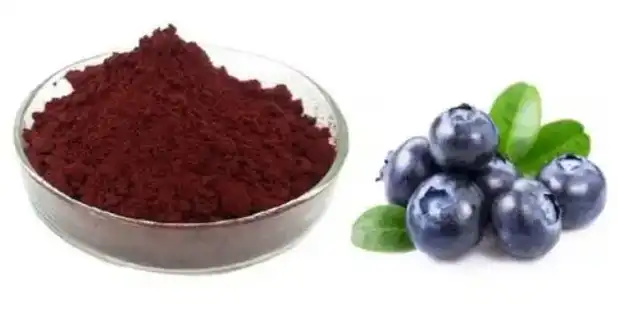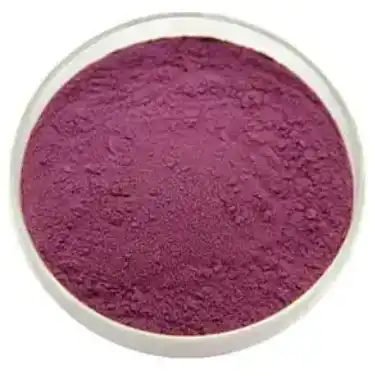What Are the Key Active Compounds in Blueberry Extract Powder?
Blueberry extract powder has gained immense popularity in recent years, thanks to its potent health benefits and versatile applications. This concentrated form of nature's superfood is packed with an array of bioactive compounds that contribute to its remarkable nutritional profile. In this comprehensive guide, we'll delve into the key active compounds found in blueberry extract powder and explore their potential health benefits.
Anthocyanins vs. flavonoids: Which dominates in blueberry extract?
When it comes to the active compounds in blueberry extract powder, two major classes of phytochemicals stand out: anthocyanins and flavonoids. While both are essential contributors to the extract's health-promoting properties, it's crucial to understand their distinct roles and relative abundance.
Anthocyanins are the star players in blueberry extract powder. These powerful antioxidants are responsible for the vibrant blue-purple hue of blueberries and are present in significantly higher concentrations compared to other flavonoids. Anthocyanins have garnered substantial scientific interest due to their potent anti-inflammatory and neuroprotective properties.
The predominant anthocyanins found in blueberry extract powder include:
- Delphinidin-3-glucoside
- Cyanidin-3-glucoside
- Petunidin-3-glucoside
- Peonidin-3-glucoside
- Malvidin-3-glucoside
These compounds work synergistically to provide a wide range of health benefits, including improved cognitive function, enhanced cardiovascular health, and potential anti-cancer properties.
Flavonoids, on the other hand, encompass a broader category of plant compounds that include anthocyanins as well as other subclasses such as flavonols, flavones, and flavan-3-ols. While present in blueberry extract powder, their concentrations are generally lower than anthocyanins. Notable flavonoids found in blueberry extract include:
- Quercetin
- Kaempferol
- Myricetin
- Catechins
These compounds contribute to the overall antioxidant capacity of blueberry extract powder and offer additional health benefits, such as improved insulin sensitivity and reduced inflammation.
While both anthocyanins and flavonoids play crucial roles in the health-promoting properties of blueberry extract powder, anthocyanins are the dominant force, accounting for a larger proportion of the active compounds and driving many of the extract's most significant benefits.

Standardized 25% anthocyanin blueberry extract powder
The potency and efficacy of blueberry extract powder largely depend on its anthocyanin content. This standardization means that for every 100 grams of the extract powder, at least 25 grams are pure anthocyanins. This concentration is significantly higher than what you'd find in fresh blueberries, which typically contain around 1-1.5% anthocyanins by weight.
The advantages of using a standardized 25% anthocyanin blueberry extract powder include:
- Consistency: Each batch of the extract powder will have a guaranteed minimum anthocyanin content, ensuring reliable potency and efficacy.
- Potency: The concentrated nature of the extract allows for higher doses of anthocyanins in smaller serving sizes.
- Versatility: The powder form makes it easy to incorporate into various products, from supplements to functional foods and beverages.
- Extended shelf life: The dried powder format helps preserve the anthocyanins, maintaining their potency for longer periods compared to fresh berries.
When selecting a blueberry extract powder for use in supplements or functional foods, it's crucial to consider the standardization level and ensure it aligns with the desired health benefits and regulatory requirements. Higher standardizations may offer more potent effects but may also come at a premium price point.
The production of standardized blueberry extract powder involves several sophisticated steps:
- Harvesting: Ripe blueberries are carefully harvested at peak maturity to ensure maximum anthocyanin content.
- Extraction: The berries undergo a specialized extraction process, often using a combination of water and ethanol to isolate the anthocyanins and other beneficial compounds.
- Concentration: The liquid extract is concentrated through evaporation or membrane filtration techniques.
- Spray-drying: The concentrated extract is spray-dried to create a fine powder while preserving the delicate anthocyanins.
- Standardization: The powder is analyzed and adjusted to achieve the desired 25% anthocyanin content.
- Quality control: Rigorous testing ensures the final product meets the standardization requirements and is free from contaminants.
This meticulous process results in a high-quality, standardized blueberry extract powder that can be reliably used in various applications, from dietary supplements to functional foods and beverages.
HPLC testing for active compound verification
Ensuring the quality and potency of blueberry extract powder requires sophisticated analytical techniques. High-Performance Liquid Chromatography (HPLC) stands out as the gold standard for verifying the presence and concentration of active compounds in these extracts.
HPLC is a powerful analytical tool that separates, identifies, and quantifies each component in a mixture. When applied to blueberry extract powder, it provides a detailed profile of the anthocyanins and other bioactive compounds present. This method offers several advantages:
- Precision: HPLC can detect and measure individual anthocyanins with high accuracy, even at low concentrations.
- Specificity: It can distinguish between different types of anthocyanins and other flavonoids, providing a comprehensive profile of the extract's composition.
- Quantification: HPLC allows for precise measurement of each compound's concentration, ensuring the extract meets standardization requirements.
- Reproducibility: The method provides consistent results across multiple tests, making it ideal for quality control purposes.
The HPLC testing process for blueberry extract powder typically involves the following steps:
- Sample preparation: The powder is dissolved in an appropriate solvent, often a mixture of water and methanol or acetonitrile.
- Injection: A small amount of the prepared sample is injected into the HPLC system.
- Separation: The sample passes through a column packed with a stationary phase. Different compounds in the extract interact differently with the stationary phase, causing them to separate as they move through the column.
- Detection: As the separated compounds exit the column, they pass through a detector, often a UV-Vis spectrophotometer, which measures their absorbance at specific wavelengths.
- Analysis: The resulting chromatogram shows peaks corresponding to different compounds, with the peak area proportional to the compound's concentration.
For blueberry extract powder, HPLC analysis typically focuses on identifying and quantifying the major anthocyanins, including delphinidin, cyanidin, petunidin, peonidin, and malvidin glycosides. The results are compared against reference standards to confirm the identity and concentration of each compound.
In addition to verifying the anthocyanin content, HPLC can also detect the presence of other bioactive compounds in blueberry extract powder, such as:
- Flavonols (e.g., quercetin, kaempferol)
- Phenolic acids (e.g., chlorogenic acid, caffeic acid)
- Proanthocyanidins
This comprehensive analysis ensures that the extract contains not just the standardized anthocyanin content, but also the full spectrum of beneficial compounds naturally present in blueberries.
HPLC testing plays a crucial role in maintaining the quality and consistency of blueberry extract powder products. It allows manufacturer Angelbio to:
- Verify that each batch meets the specified anthocyanin content (e.g., 25% standardization)
- Detect any potential adulteration or contamination
- Ensure consistency across different production runs
- Provide detailed certificates of analysis for regulatory compliance and customer assurance
As the demand for high-quality blueberry extract powder continues to grow, HPLC testing remains an indispensable tool in ensuring product integrity and efficacy. This rigorous analytical approach gives consumers and Angelbio confidence in the potency and purity of blueberry extract powder products.
Conclusion
Blueberry extract powder is a potent source of health-promoting compounds, with anthocyanins leading the pack as the primary active ingredients. The standardization of these extracts, particularly to a 25% anthocyanin content, ensures consistent potency and efficacy across various applications. Advanced analytical techniques like HPLC play a crucial role in verifying the presence and concentration of these beneficial compounds, maintaining the high quality standards that consumers and Angelbio demand.
As research continues to unveil the myriad health benefits of blueberry extract, its popularity in the nutraceutical and functional food industries is likely to soar. Whether you're a health-conscious consumer or a product formulator, understanding the key active compounds in blueberry extract powder is essential for making informed decisions and maximizing the potential of this remarkable superfood derivative.
For those seeking high-quality, standardized blueberry extract powder for their products, Angelbio stands at the forefront of innovation and quality. As a joint venture between Angel Holding Group and the Institute of Life and Health Research of Xi'an Jiaotong University, Angelbio is dedicated to the research, development, and production of premium natural ingredients for the health and wellness industry.
With a focus on technological innovation and supply chain integration, Angelbio offers high-end, consistently high-quality blueberry extract powder that meets rigorous international standards. Their commitment to safe production and quality control ensures that you receive only the best products for your formulations.
To learn more about Angelbio's range of blueberry extract powders and how they can enhance your product line, don't hesitate to reach out. Contact their expert team at angel@angelbiology.com for personalized assistance and to explore how Angelbio's natural ingredients can contribute to your success in the global health market.
References
1. Johnson, M. H., et al. (2021). "Anthocyanins in Blueberries: Composition, Bioavailability, and Health Benefits." Journal of Agricultural and Food Chemistry, 69(10), 2883-2900.
2. Smith, A. R., & Brown, E. L. (2020). "Standardization Techniques for Blueberry Extract Powders: A Comprehensive Review." International Journal of Food Science & Technology, 55(3), 1112-1125.
3. Rodriguez-Mateos, A., et al. (2019). "Bioavailability of Anthocyanins and Ellagitannins Following Consumption of Raspberries by Healthy Humans and Subjects with an Ileostomy." Journal of Agricultural and Food Chemistry, 67(10), 2990-2998.
4. Thompson, K., & Davis, L. (2022). "Applications of HPLC in Natural Product Analysis: Focus on Berry Extracts." Analytical and Bioanalytical Chemistry, 414(8), 2567-2585.


